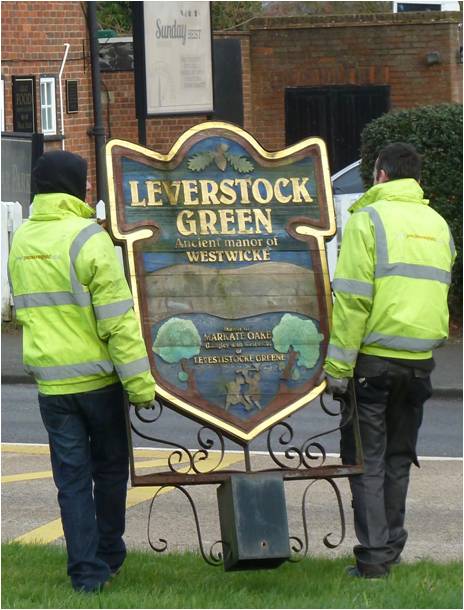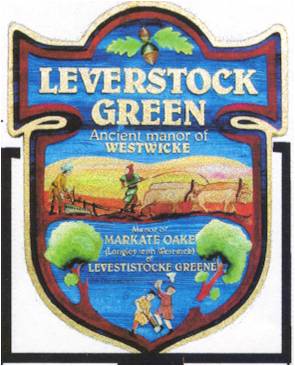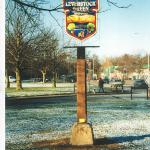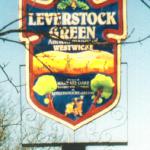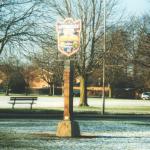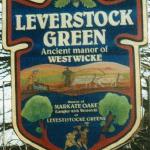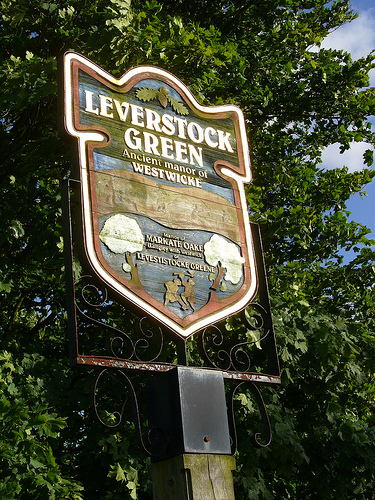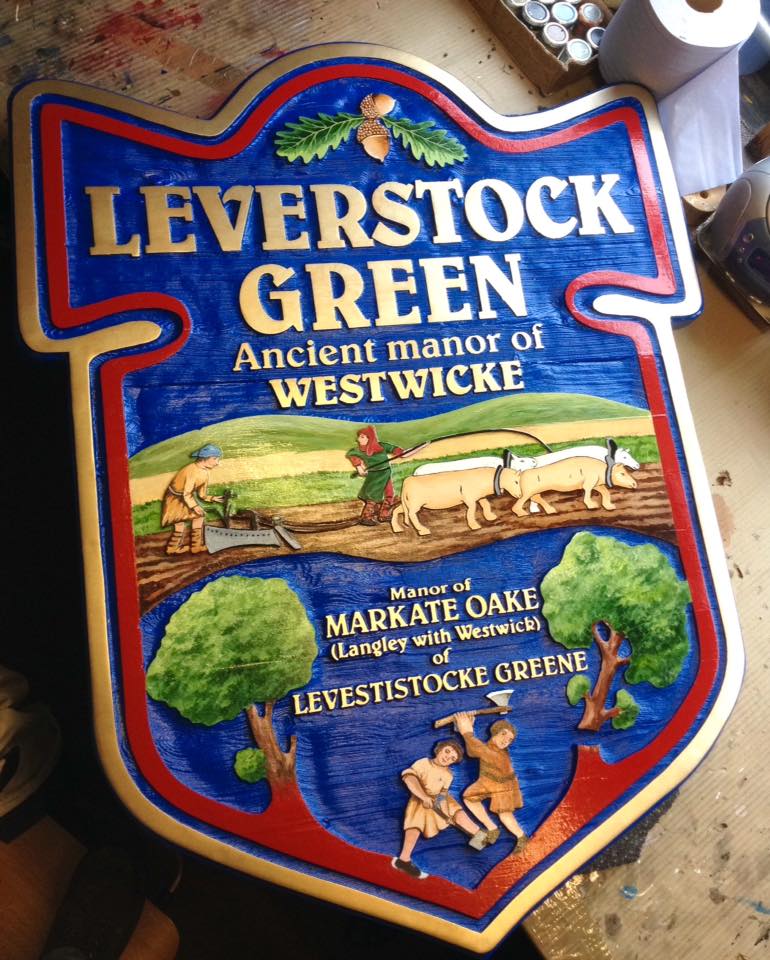VILLAGE SIGN RENEWED
This page was last updated on: November 15, 2017
THE LEVERSTOCK GREEN CHRONICLE
an in-depth history of one village in Hertfordshire UK.
Click to link to principle LG Chronicle web pages.
OUR VILLAGE SIGN
Our Millennium sign had suffered badly over the last 16 years, and was a pictorial shadow of its former self, and the wrought iron sign had grown rusty and broken. LGVA have therefore commissioned a new sign to the same design, but made of long lasting polyurethane so that once more it provides a smart and attractive focal point in the centre of the village. This photo by John Baldwin, shows the men removing the sign in February. The new sign took longer than expected to create, and was finally replaced on 3 July 2016. The new, hand painted sign has been cast in polyurethane to ensure that it lasts for many many more years.
SCROLL DOWN THE PAGE TO VIEW ALL RELATED ARTICLES AVAILABLE THEN CLICK TO VIEW. Please view @ 100% to ensure items don't overlap visually.
February 2016
December 1999
The Leverstock Green Village Sign ~
a link with our past.
an account by Barbara Chapman
At 11 a.m. On the morning of Saturday 11 December 1999, in torrential rain and a high wind, I was joined on the green in front of Church Cottages by a fair number of local residents determined to brave the weather and see the new village sign unveiled.
Earlier in the week the sign's maker: David Woollacott from Amber Signs of Berkhamsted, had with the help of a local builder, erected the sign on its oak post and flint encrusted plinth. Leaving it tantalisingly shrouded in bubble wrap and a linen cover. Audrey Armstrong having cleverly made a loose cover which I could quickly remove at the correct moment, the bubble wrap had been removed earlier in the morning. However, the driving rain had shrunk the knots in the bow, and removal wasn't quite as instant as we'd hoped! However, success wasn't long coming, and after gathering around the sign so the Gazette photographer could do his stuff, we all gladly retired to the Village Hall for a warming glass of punch and a mince pie.
Several people then asked me the significance of the wording (other than the village name) both on the sign and the brass plaque fixed to the base of the oak pole and asked if I could put a piece in the Parish Magazine explaining.
Agreed to by the members of Leverstock Green Village Association Committee the general design for the sign (a pencil sketch) complete with its wording was mine. The idea coming from the numerous pictorial village signs to be found throughout Norfolk. The only significant difference between my original sketch and the finished sign being a carved wooden boss in the style of Grindling Gibbons denoting an acorn and several oak leaves atop the shield. My intention when drawing up the original design was to indicate Leverstock Green's heritage of the last millennium so that it doesn't get forgotten with all the changes life in the twenty-first century will bring. A reminder that we are not the only generation to have lived and worked in Leverstock Green.
Despite being given a fairly free hand with the design, Teresa Woollacott of Amber Signs chose to use my idea as the basis for her design, but I think you will agree, has transformed it with jewel-rich colours into something really striking. The wooden boss proved impractical, but the shield's outline was altered to allow for a painted version. I understand sand blasting to have been the main technique used to create the translucent quality of the paint. It should also make it more durable to the elements.
The acorn and the oak leaves were important for several reasons. Firstly they are already used as part of the logo for Leverstock Green School - reproduced on their sweatshirts - so the image in association with the village is already established. Secondly, we are now part of Dacorum Borough Council, and again, their logo incorporates acorns and oak leaves. Finally, one of the aliases for the 14th to 17th century tiny Manor of Leverstock Green was Market Oak (or more often Markate Oake). Several of the original fields along the Bedmond Road have the name Market Oak incorporated in them, and during the latter part of the last century and the early part of this, an ancient Oak Tree, standing along the edge of the Bedmond Road was known as THE Market Oak. Sometimes straw plaiters would sell their wares beneath its boughs (according to hearsay) and there is a reference in the school log book in 1864 "Thursday 3rd(October)- Market day - Very cold - let the children go for a run as far as Market Oak."
From Saxon times to the abolition of manorial courts in the 1920's, the Manor of Westwick was the principle manor of the village. The manor as a whole stretched from Green Lane in the west to Pimlico, and incorporated Potters Crouch Gorhambury and Pre. Indeed for much of its history following the dissolution the names Gorhambury and Westwick were synonymous - or almost. The name still survives along Westwick Row with Westwick Farm, Westwick Cottage, Westwick Warren and Westwick Row Farm; and indeed we have two Women's Institutes in Leverstock Green: Leverstock Green WI and Westwick WI. Westwick was important in medieval times as it supplied the wherewithal to keep the Abbey at St. Albans supplied with all its needs for the refectory, either in kind or in funds from timber etc. Westwick's chief crops were arable, and a huge tithe barn was situated along Westwick Row more or less opposite today's Westwick Warren. We now know that, for some of the time at least, Westwick's manor house was situated at Westwick Cottage (some parts of which when dated from some of its timbers proved to have been built between 1184 &1219) These facts persuaded me to show medieval peasants ploughing the land, as almost all of Westwick's land was under the plough at this time.
The bottom half of the sign shows medieval peasants felling trees. This seemed appropriate on several counts, as in the early middle ages much of the land which had become encroached on by woodland since the demise of Roman rule, would have had to have been cleared in order to reveal the good arable land beneath. In addition, the word "stoc" means a tree stump. It is possible that the name Leverstock Green refers in some way to a tree stump. We know from old documents that assarts had been created - that is land where the trees were felled, and woodland cleared.
The wording in the bottom half of the shield: Manor of Markate Oak, (Langley with Westwick) or Levestistocke Greene, gives three of the alternative names and spellings of the small Manor of Market Oak mentioned above. Originally part of the manor of Westwick, this small manor stretching from what is now Church Road to Blackwater Lane between the two main roads, was carved out and given to the nuns of Markyate Priory in the 13th century. (Hence the name Markate; it eventually became part of the whole manor again in the 17th century.) Many documents relating to this manor referred to: ".......in the Manor of Markate Oake alias Langley with Westwick alias Leverstock Green (spelt in a variety of ways including Levestistocke)
Leverstock Green proper was in fact just a green - i.e. A stretch of common land on either side of the straight Roman Road, and ran from where Church Cottages are now to High Street Green. The village (as it was before the changes caused by the coming o f the New Town, ) grew up from the 17th century at the point where the roads diverted towards Watford and St. Albans, with settlement still remaining (as it has to this day) along Westwick Row.
The wording on the brass plaque fixed to the oak post reads:
This sign was caused to be erected by
LEVERSTOCK GREEN
VILLAGE ASSOCIATION
at the beginning of the year
2000 AD
to commemorate the vigorous community
which has flourished here during past millennia
and which continues in strength into the new Millennium,
proud of its own identity.
We have documentary and archaeological proof that people lived and worked in the immediate area of Leverstock Green from the time of the Roman occupation onwards. Recent research indicates that settlement along Westwick Row may well date back even further to the Iron age and perhaps the Bronze Age. It seems quite likely that this settlement was a "suburb" of the major Iron Age settlement at Pre Wood just outside St. Albans. We will continue the tradition of the last two millennia into the third.
I hope Leverstock Green's residents will come to feel as proud of this symbol of Leverstock Green's identity as I was when I unveiled it for all to see.
Barbara Chapman
Chairman LGVA & Local Historian.
January 2000
Above Original Sign Design, 1999
After 16 years the sign started looking far from its best.
Including the history of the design and erection of the original sign.
ORIGINAL SIGN GALLERY - Click on the left photo on each line, then navigate to the right.
© John Baldwin
© Martin Chapman
The newly restored sign 1 July 2016
Photographs © Martin Chapman
The sign, Tessa Daniels having finished painting it, was giving it a final check above, before it was put back in its frame. Tessa had previously been a Leverstock Green Resident, so was particularly interested in doing this sign.
THE ORIGINAL SIGN UNVEILED - DECEMBER 1999
Warning to MAC users of SAFARI,
Apple’s default internet programme.
When using SAFARI, formatting, of text-boxes and other items can be distorted and/or overlayed. Switching to a different browser e.g. Opera, will usually correct this.
Having problems with links not working?
Then please....
